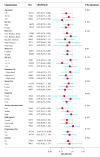Association between composite dietary antioxidant index and hyperlipidemia in adults based on the NHANES
- PMID: 39827264
- PMCID: PMC11742980
- DOI: 10.1038/s41598-025-86223-4
Association between composite dietary antioxidant index and hyperlipidemia in adults based on the NHANES
Abstract
Hyperlipidemia, a major risk factor for cardiovascular diseases, can potentially be alleviated by dietary antioxidants. This study explored the relationship between hyperlipidemia and the Composite Dietary Antioxidant Index (CDAI), which measures antioxidant intake from carotenoids, selenium, zinc, and vitamins A, C, and E. Analyzing data from 27,493 participants aged 20 and older from the National Health and Nutrition Examination Survey (NHANES) conducted between 2001 and 2018, we used weighted regression models to assess this association while adjusting for multiple covariates. Restricted cubic splines were also applied to check for any non-linear relationships. Findings revealed that higher CDAI scores significantly correlated with lower hyperlipidemia prevalence. Specifically, each unit increase in log-transformed CDAI was linked to a 14% decrease in hyperlipidemia risk (OR = 0.86, 95% CI: 0.77-0.95). Participants in the top CDAI quartile had a 15% lower hyperlipidemia prevalence compared to those in the bottom quartile (OR = 0.85, 95% CI: 0.77-0.95). No significant non-linear relationship was observed (p = 0.822). In conclusion, increased antioxidant intake, as measured by CDAI, is associated with reduced hyperlipidemia, underscoring the role of antioxidants in its management.
Keywords: Composite dietary antioxidant index (CDAI); Cross-sectional analysis; Dietary antioxidants; Hyperlipidemia; NHANES.
© 2025. The Author(s).
Conflict of interest statement
Declarations. Competing interests: The authors declare no competing interests.
Figures



Similar articles
-
Association between composite dietary antioxidant index and hyperlipidemia: a cross-sectional study from NHANES (2005-2020).Sci Rep. 2024 Jul 10;14(1):15935. doi: 10.1038/s41598-024-66922-0. Sci Rep. 2024. PMID: 38987566 Free PMC article.
-
Association between composite dietary antioxidant index and the prevalence of periodontitis: results from NHANES 2009-2014.BMC Oral Health. 2025 May 24;25(1):779. doi: 10.1186/s12903-025-06151-7. BMC Oral Health. 2025. PMID: 40413422 Free PMC article.
-
Bone mineral density is associated with composite dietary antioxidant index among US adults: results from NHANES.Osteoporos Int. 2023 Dec;34(12):2101-2110. doi: 10.1007/s00198-023-06901-9. Epub 2023 Sep 4. Osteoporos Int. 2023. PMID: 37666910
-
Sex differences in the association between composite dietary antioxidant index and hyperlipidemia: Insights from NHANES.PLoS One. 2025 Jan 10;20(1):e0316130. doi: 10.1371/journal.pone.0316130. eCollection 2025. PLoS One. 2025. PMID: 39792922 Free PMC article.
-
The independent and joint relationships between dietary antioxidant intake with risk of chronic obstructive pulmonary disease and all-cause mortality: insights from NHANES.Front Public Health. 2025 Jan 29;12:1393119. doi: 10.3389/fpubh.2024.1393119. eCollection 2024. Front Public Health. 2025. PMID: 39944568 Free PMC article.
Cited by
-
Association of composite dietary antioxidant index and endometriosis risk in reproductive-age women: a cross-sectional study using big data-machine learning approach.Front Nutr. 2025 Mar 27;12:1572336. doi: 10.3389/fnut.2025.1572336. eCollection 2025. Front Nutr. 2025. PMID: 40212718 Free PMC article.
-
Association between composite dietary antioxidant index and rheumatoid arthritis: results from NHANES 2003-2018.Int J Med Sci. 2025 Feb 18;22(5):1184-1193. doi: 10.7150/ijms.107332. eCollection 2025. Int J Med Sci. 2025. PMID: 40027194 Free PMC article.
-
Association between the composite dietary antioxidant index and cardiovascular-kidney-metabolic syndrome among U.S. adults: evidence from NHANES 2007-2018.Front Nutr. 2025 Jul 10;12:1600651. doi: 10.3389/fnut.2025.1600651. eCollection 2025. Front Nutr. 2025. PMID: 40709338 Free PMC article.
References
-
- Vikulova, D. N., Trinder, M., Mancini, G. B. J., Pimstone, S. N. & Brunham, L. R. Familial hypercholesterolemia, familial combined hyperlipidemia, and Elevated Lipoprotein(a) in patients with premature coronary artery disease. Can. J. Cardiol.37, 1733–1742 (2021). - PubMed
Publication types
MeSH terms
Substances
Grants and funding
LinkOut - more resources
Full Text Sources
Medical

